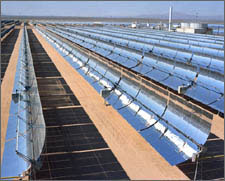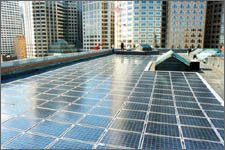
The parabolic troughs that make up this concentrating solar power system generate power from the sun on a large scale in California.

A 28-kW photovoltaic (PV) system is integrated into the roof of the Williams Building in downtown Boston, Massachusetts, to provide solar electricity for the building.

The Chesapeake Bay Foundation's headquarters in Annapolis, Maryland, has many energy-efficient and renewable energy features. These features include natural ventilation, extensive daylighting, a solar water heating system, a 4-kW photovoltaic (PV) system, native landscaping, geothermal wells, and structurally insulated panels.

Flexible optical fibers efficiently pipe sunlight into buildings and route the natural light to multiple hybrid light fixtures.
The U.S. Department of Energy's Solar Energy Technologies Program conducts research and development in three major technology areas: concentrating solar power; solar electricity, also known as photovoltaics or PV; and solar heating and lighting. Whether you are a consumer, an educator, a student, a prospective R&D partner, or just curious, these pages can help you learn more about solar energy technologies.
All these solar energy technologies put the sun's energy to work for us in our homes, schools, businesses, and government buildings. They are being developed because they are reliable, they have very few environmental impacts, and they make use of an abundant domestic energy resource: sunlight.
In this section, you will learn some of the basics of today's solar energy technologies: what they are, why they are important, and how they can be used to produce heat, light, and power. But there's more. You can also find out about the latest materials, methods, and manufacturing processes that will lead us to the exciting solar technologies of the future.
Concentrating Solar Power
These technologies—such as dish/engine systems, parabolic troughs, and central power towers—are made of reflective materials that focus or concentrate the sun's considerable heat energy. This concentrated solar energy then drives a generator to produce electricity.
Photovoltaics
This solar electric technology makes use of semiconductors to convert sunlight directly to electricity. Photovoltaics can provide a very small amount of electric power for your solar watch or calculator, or a very large amount of power for your local electric utility—and any amount in between.
Solar Heating
Solar heating technologies make use of low-temperature solar collectors that absorb the sun's heat energy, allowing that heat to be used directly for water or space heating in residential, commercial, and industrial buildings.
Solar Lighting
Solar lighting technologies rely on roof-mounted solar concentrators to collect sunlight; then, they distribute that light through optical fibers to hybrid lighting fixtures in the building's interior. These fixtures are called hybrids because they combine natural light with electric light to illuminate interior spaces.

















